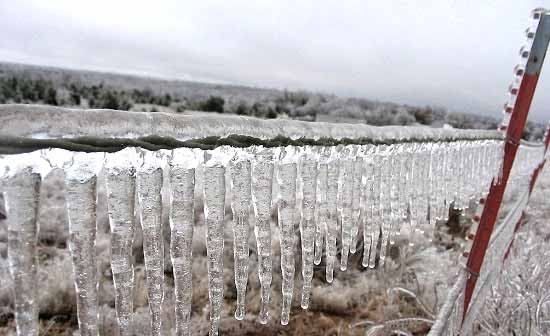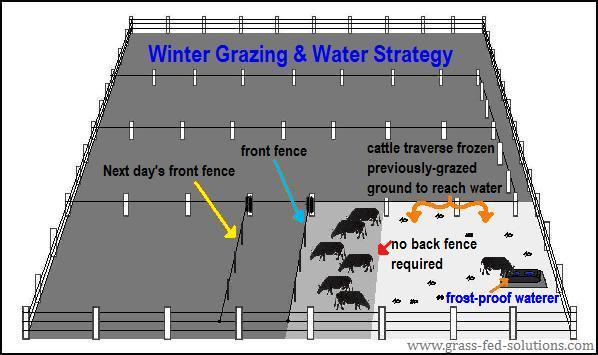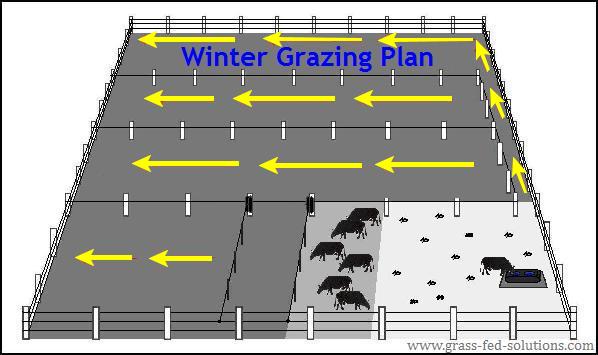The Smart Electric Fence Grid
Electric Fencing and Cattle Water in Winter

Image Credit: Josh
Winter brings a whole new set of challenges to your electric fencing and cattle watering system. Frost will wreak havoc on unprepared waterlines. Snow and frozen ground act as insulators that can completely neutralize the 'bite' of an ill-prepared electric fence system. But with just a little bit of extra planning and preparation, your electric cattle fence grid and livestock water system can continue to function effectively right through the winter grazing season without missing a beat.
The previous articles in this Smart Electric Fence Grid series focused on how to set up and manage your electric fence and water infrastructure during the frost-free part of the year. This section will focus on the frost-season.
I will show you how a few well-placed frost-proof livestock water sites can comfortably provide for all your cattle's drinking water needs without affecting the flexibility of your winter pasture rotation, all thanks to a switch to a different grazing strategy during the winter when grass is no longer growing. The very same frost that forces you to shut off and drain your summer water system is also the saving grace that shuts off grass growth so your cattle can access distant frost-proof water sites without spoiling future pasture re-growth.
Keeping your electric fence grid working smoothly during the winter months is also not difficult. By following a few simple guidelines during electric fence construction, ground rod layout, and energizer selection, and by incorporating a few simple winter electric fencing strategies into your farm fencing plan, your electric fence grid will continue to work smoothly throughout the winter grazing season.
Step-by-Step Electric Fence Planning - Grazing and Water in Winter
Use the links below to review steps 1-4 in the Electric Fence Installation and Planning process - focused on the frost-free part of the year - before continuing with this article about how to adapt your cattle water system and electric fence grid to the frost season.
Step # 5: How to set up a few well-placed frost-proof livestock water sites, plan a logical winter pasture rotation, and winterize your fence grid so you can seamlessly continue your daily rotational grazing program deep into the winter months.
Making sure that your pasture fence and cattle water infrastructure is able to support your winter grazing program in the frost-prone regions of the world requires a very simple three-pronged approach:
- A pre-planned winter pasture rotation.
- A few well-placed frost-proof cattle water sites designed to support your pre-planned winter pasture rotation.
- And a winterized fence grid designed to cope with the extra challenges of maintaining an effective electric fencing system during the cold winter months.
I'll discuss each of these three parts below:
The Winter Pasture Rotation
Adapting your cattle water and electric fence infrastructure for winter grazing starts with a quick review of how to manage your winter grazing routine. You can read a complete in-depth discussion about how to prepare your pastures for winter grazing and about winter grazing strategies by following the links.
Managing the Daily Winter Grazing Routine:
Grazing during the winter when the grass is dormant involves a completely different grazing strategy.
While you should still continue to use daily pasture slices throughout the winter grazing season, do not leave a tall grass stubble for quick re-growth as you would during your summer pasture rotation. Instead your cattle should completely use up all the grass available in each pasture slice before moving on to the next slice in their winter pasture rotation. Grazing each slice more completely means using smaller daily pasture slices, not less frequent pasture moves.
At the start of the frost season you will need to shut off and drain the extensive summer livestock water system discussed in Part V of this article series to prevent pipes and troughs from freezing solid (or breaking). This leaves only your select few frost-proof livestock water sites to support your entire winter pasture rotation. However, your rotational grazing program can continue unaffected, despite losing access to the summer water system, because the frost also stops plant growth during the winter and kills all but the roots of your pasture grasses...
Because there is no re-growth in your pastures once the frost season starts, you do not need to protect previously-grazed pastures from your cattle. And because winter grazing means using up each pasture slice completely, there is no un-used cattle feed that will be trampled if the cattle are allowed to walk back across previously-grazed pastures to reach a distant frost-proof livestock water site.
This means you won't need a back fence during the winter grazing season. Your cattle can simply walk back across previously-grazed pastures to reach your frost-proof livestock waterers, as shown in the image below.
Step # 5: Your winter pasture rotation depends on pre-planning a logical grazing rotation that is supported by a few well-placed frost-proof livestock water sites and an electric fencing grid designed with winter in mind. Plan your winter livestock water system and winter grazing plan as a separate layer in your farm plan maps.
While the portable electric back fence normally used during the growing season (short red arrow in the image above) is not required during winter grazing, it is still extremely important to continue to protect un-grazed pastures using both the front fence (light blue arrow) and the next day's front fence (yellow arrow) because the risk of the first front fence failing is even higher in the winter.
Managing Access to Previously-Grazed Pastures
While a back fence is not needed during the winter grazing season, it is nonetheless useful to restrict access to the majority of the previously-grazed pastures so that your cattle only have access to temporary alleys or corridors to reach the water sites. Do not allow your cattle to scatter across all the previously-grazed pastures. This prevents manure (and nutrients) from being transported out of the pasture to favorite hangouts and ensures that your cattle always bed down on each day's freshly-grazed ground rather than re-using favorite bedding areas where manure, mud, and disease pressures would be concentrated.
Create simple temporary water alleys to the cattle water sites using portable electric fences, which are easy and quick to build and can be extended, moved, or removed as needed.
Planning the Winter Pasture Rotation and Locating Frost-Proof Water Sites
The terrain and layout of your farm will determine how many frost-proof livestock waterers you will need. You won't need many.
The trick is to pre-plan a logical grazing rotation for the winter months that will progressively take your herd further and further from the water source without ever causing your cattle herd to have to cross un-grazed pastures to walk back to water.
The image below shows an idealized winter grazing plan. Notice how each big corridor starts grazing as close as possible to the water trough rather than completing a full loop of the farm as you would in the summer pasture rotation (for comparison with the winter grazing plan in the image below, click the link to see the idealized summer pasture rotation)...
This winter grazing pattern through your pasture corridors ensures that your cattle always take the most direct route back to water without having access to the other previously-grazed corridors. This strategy also minimizes how many temporary pasture fences you have to put up to restrict access to previously-grazed areas within each corridor.
Pre-plan a logical winter pasture rotation to show how you will use your electric fencing grid to ration out your grass and provide access to water throughout the entire winter rotational grazing season.
You can see an actual winter grazing plan that shows this outward progression from a frost-proof cattle water site in the linked grazing plan example.
On flat ground, a single, central, well-maintained frost-proof water site can easily service a full section of land (1 section = 640 acres).
As the distance to water increases, your cattle herd will likely voluntarily switch over to eating snow as their primary source of cattle drinking water, but you will still need at least one frost-proof cattle water site for the shoulder seasons when there is no clean snow, for periods of freezing weather without snow, and to provide water until the cattle voluntarily decide to switch over to eating snow for their drinking water needs.
Make sure you plan the 'flow' of your entire winter pasture rotation on a separate transparent overlay on your farm map. Transparent map overlays for your grazing plan are discussed here.
Your winter grazing plan needs to address:
- Where will you start your winter grazing rotation so you can graze progressively outwards away from your winterized water site(s) while encouraging the cattle to eat snow once the trek back to water becomes tedious?
- Where will your cattle graze during extreme cold snaps? - Save heavily-timbered areas for this purpose because of the shelter they provide.
- Where will your cattle end the winter season to ensure they are on firm well-drained high ground when the mud season starts? (More on that below.)
- Which areas are prone to heavy snow drifts? - These areas should be grazed early in the winter season before the snow pack gets thick.
- Which areas are prone to wind erosion? - These are great areas to save for when the snow pack gets particularly thick in other areas of the farm.
Planning for the Spring Thaw
Plan your winter grazing rotation so that your cattle will be back near a frost-proof water source near the end of the winter season to avoid long commutes to water across muddy pastures during the spring thaw.
Build your frost-proof livestock waterer immediately adjacent to a pasture specifically designated for grazing during the spring thaw to minimize walking distances to water during the mud season. This pasture should be on high ground and have firm well-drained soil. Save this pasture for the few weeks when soil turns to soup as the frost comes out of the ground.
This spring-thaw pasture is your insurance policy to protect the remainder of your pastures against excessive trampling while the sod mat is vulnerable during the spring thaw. By building your livestock waterer immediately adjacent to this spring-thaw pasture, you also minimize your cattle's temptation to drink from dirty puddles that form during the spring thaw - easy access to water is an important factor in minimizing disease pressures during the mud season.
In some cases, if your area gets particularly muddy, then this spring-thaw pasture should be a small feed pen on firm ground that allows you to feed hay for a few weeks until the pastures dry up sufficiently to return to grazing. This pre-planned strategy is key to protecting pasture grasses from excessive trampling during the brief but intense spring mud season.
Frost-Proof Water Site Construction Tips
Site Drainage
Build your frost-proof water site on high ground, on well-drained soils or a gravel pad so that the area around the water site doesn't turn into a treacherous bog. If a livestock waterer is located on a concrete pad, make sure that the concrete pad is surrounded by firm gravel that is level with the concrete pad. A steep step off of a concrete pad, particularly if it is into the deep mud that commonly forms around winter water sites, is a very common source of minor foot injuries, which subsequently attract bacteria and lead to infections (i.e. 'foot rot').
Level Access
Level access to a winterized water site is extremely important to prevent injuries as slopes turn to ice. A water trough located at the top of a long hill, or with a steep approach, is just as undesirable as a poorly drained water site in a gully.
Many cattle ranchers choose to use direct access to creeks or ponds during the winter as an alternative to a permanent livestock waterer. But the sloped access to these natural water courses will typically turn into a treacherous slide in the winter, leading to falls that cause injuries or aborted foetuses. Falling into water, or having to step into a freezing steam to stop an uncontrolled slide down an embankment is dangerous to cattle health during sub-zero weather and getting wet is a serious drain on their energy reserves.
If you must use direct access to an open water course, you will need to maintain the approach with heavy gravel applications all winter long. It's usually safer for your cattle (and your time is better spent) to gravity-feed water into a trough on level ground up on the bank with the overflow piped back into the stream so that the rapidly-flowing water keeps the trough from freezing over.
Herd Size (And Water Demand) Matters
Unless you use a heated water trough, most energy-free frost-proof water solutions are herd-size specific. If your energy-free trough relies on the water temperature to keep the trough ice-free, these troughs are designed according to how much water turnover will occur each day. If demand declines because you split your herd into multiple groups partway through the winter or because your cattle herd begins to supplement their drinking water needs by eating snow, water use at the trough will be insufficient to keep the trough ice-free. If you anticipate inconsistent water use at a frost-proof water site, either opt for a heated trough, or pick a trough design that allows you to respond to changing water demands without risk of freezing over (such as providing multiple small energy-free troughs that can be individually turned on or off as demand changes).
The 'Livestock Water' chapter of my book, Grass-Fed Cattle: how to produce and market natural beef, provides a comprehensive overview of frost-proof cattle water options and energy-free water trough designs, including:
- Continuous-flow water troughs that use the temperature of the flowing water to keep the trough ice-free,
- Ice preventer valves that inject fresh water into the trough from the supply line as soon as they sense the temperature of the water in the trough approaching freezing,
- Several energy-free trough designs that make use of latent heat in the ground to circulate either water or air to keep the trough from freezing,
- Gas bubblers used to keep ponds or slow moving streams from freezing over by creating currents in the water,
- And the chapter also includes further discussion about how to safely use snow as a water source during your winter rotational grazing program.
With the winter grazing plan in hand and frost-proof cattle water figured out, all that's left to complete your Smart Electric Fence Grid is some pointers about how to build and operate an electric fencing grid that can withstand the rigors of winter...
Continue to:
Related Articles:From the Smart Electric Fence Grid series:
Other articles:
(Disclosure: I get commissions for purchases made using Amazon links in my post.) And when you're ready to start planning your cattle farm, check out my book: Grass-Fed Cattle: How to Produce and Market Natural Beef. Use the links below to explore my book and read reviews on Amazon: 
|
|
Share: |
|




